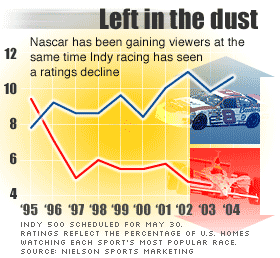
NEW YORK (CNN/Money) - This is a big weekend for auto racing. Nascar's Coca-Cola 600 will be held Sunday night, a few hours after the end of the day's second-most popular race, the Indianapolis 500.
It's shocking to refer to it that way, but the Indy 500, once the premier auto race in the world, has clearly fallen on hard times in recent years. And it shows little signs of recovering.
Indy's ratings are about half what they were 10 years ago, while Nascar's overall ratings have shifted into high gear. It's been three years since the Indy 500 has beaten the Coca-Cola 600 in ratings, and it's been nine years since it had higher ratings that Nascar's most popular race, the Daytona 500.
The open-wheel portion of auto racing has been left stuck in the pits as Nascar has raced to success.
What's more, many of its worst problems are self inflicted. Most of the decline has taken place since open-wheel racing was ripped into bitter competing camps.
An uncivil war
In June 1994, Indianapolis Motor Speedway owner Tony George broke with what was then the sport's sanctioning body, CART, to start the Indy Racing League. He kept the sport's premier race but temporarily lost access to many of its top drivers.
CART soon spiraled down and was forced to file for bankruptcy year.
"Since the split, Nascar -- which was kind of neck-and-neck with CART -- has taken advantage and done a brilliant job," said Kevin Kalkhoven, one of the three general partners who bought the assets of the old CART circuit out of bankruptcy court for about $3.5 million this past off-season.

IRL bid about $10 million more cash for the CART assets than Kalkhoven did. But a bankruptcy judge ruled that the offer from Kalkhoven's group, Open Wheel Racing, was worth more because of its offer to honor CART liabilities and hold the races that IRL would have suspended or dropped altogether.
Both sides take frequent shots at one another, which isn't doing the sport any good in building fan interest.
"It was a great race, but they've managed to ruin it," said Kalkhoven about the Indy 500.
Even the qualifying events were big events once. "It used to be 60 or 70 cars competing to get in the race (on qualifying day) with more than 100,000 watching," he said. "Now, they had to struggle to get up to 33 cars with 10,000 people in the stands" to watch the qualifiers.
| 
| |

| 
| 
|

|
 Ken Ungar, senior VP of the Indy Racing League, and Helio Castroneves, a two-time Indy 500 winner, talk about Sunday's big race. Ken Ungar, senior VP of the Indy Racing League, and Helio Castroneves, a two-time Indy 500 winner, talk about Sunday's big race.
|
 Play video
Play video
(Real or Windows Media)
|
| 
|

|
|
But IRL argues that the CART bankruptcy is proof that it has won the competition for open wheel racing fans.
"It's less of a problem than it has been," said IRL executive vice president Fred Nation about the split in the open wheel circuit.
"Most of the major owners, sponsors, teams, and manufacturers have moved from CART to IRL," he noted. "Having said that, as long as there is some vestige of CART remaining that is a dedicated to continuing a war of words against us, it creates some confusion in the marketplace."
| SportsBiz
|

|
| Click here for SI.com sports coverage
|
|
|
|
The competition shows no signs of abating. In fact, it may get more intense, and maybe more destructive.
Next year, IRL will host its first road or street races, moving away from its oval track base and into the type of racing where Open Wheel Racing Series has its best success with races like the Grand Prix of Long Beach.
Both open wheel circuits have become dominated by foreign born drivers. That's created another edge for Nascar, whose drivers are overwhelmingly U.S.-born, in its competition for U.S. race fans. A U.S.-born driver hasn't won Indy since 1998. But the bigger problem is that neither U.S.- nor foreign-born drivers have been as well promoted as the Nascar drivers, said Kalkhoven.
"It's almost impossible to say who won Indy five years ago, or who won Long Beach five years ago, because we haven't promoted the drivers," he said.
This week, ABC and ESPN announced an extension of their deal to broadcast IRL races through 2009. The previous IRL deal was worth only a reported $13 million a year, compared to about $400 million a year Nascar gets from Fox, NBC and its cable partners. Nation said IRL's new deal is "very comparable" to the previous one.
The average rating of IRL races on ABC other than the Indy 500 programming is only 0.9, meaning they are watched in less than 1 percent of U.S. homes.
A peace accord in the open wheel circuit can't come soon enough, but it isn't likely to happen. And as long as open wheel racing is more demolition derby than the high-powered promotion machine of Nascar, it will continue to sputter farther behind its fast-moving rival.

|

